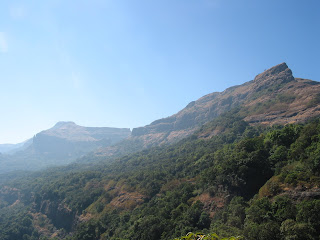
The most used route to reach the fort is via Ratanwadi village. If you live in Bombay this means a long route to Igatpuri, then to Shendi (Bhandardhara Dam) and then a boat to Ratanwadi. Being late for booking train tickets (as usual), we took the first bus to Nasik that would drop us to Igatpuri. Unfortunately we got stuck in the mother of all jams and after four hours of being stuck (we got by with playing cards), we got down at Asangaon, took a train to Kasara, then a bad jeep ride to Ghoti and by rickshaw to Shendi and after an hour’s wait, the boat to Ratanwadi. To save time and money, I would suggest the first train to Kasara (if not a late night bus to Igatpuri) and then a bus to Rajur which would drop you at Shendi.
We spent the night at Ratanwadi as we reached there at six in the evening. There is a beautiful temple (Amruteshwar) and an ancient tank in the village. One can stay in a hall besides the temple and villagers are quite helpful. You will have every second fellow asking to be your guide! Post-dinner we went for a night walk without torches, as the moon was unusually bright and with a tripod we were shot some snaps.
We struggled to wake up at six; it was dark and freezing cold, possibly 5 degrees. We had asked one of the villagers to be our guide and when he did not show up by seven we were off. The route to the fort is forested but quite easy and distinct. At one point, it bifurcates to the route going further to Kathra and thereafter to Harischandragad (a circuit I want to do at least once!) Our guide did join us just as we started hiking and kept a good pace for us to follow.
We made it to the top in a couple of hours; there are two steel ladders just near the entrance to negotiate a rock face. After biscuits and kachoris, we went to the top where one gets excellent views of Ajoba. The highest point of the fort is the Nedhe – a hole in the rock where one gets fantastic views – as far as Jivdhan and Dhakoba. We planned to go down by the Trimbak Darwaja on the other side of the fort, which meant traversing the entire fort. The darwaja opens up into the ground and in monsoon would be real adventure. The huge steps descend steeply between huge rock walls, then the narrow route passes under a rock wall towards the Khunta Pinnacle. On one hand you can see the drop into Konkan, with another pinnacle called Baan at half level. On the other side you see the Kalsubai range up to Kulang. After going around the Kuntha pinnacle, we descended down and had a long walk to Samrad village.
Our plan was to do down Karoli Ghat from Samrad. We had a lunch break of sandwiches, while our guide gave us some delicious thecha with rice bhakris. From Samrad we walked further towards Ghatgar village where another dam has been built. This route is largely on a pucca road and luckily we got a rick to cut it short. Dropping us near an abandoned school (now submerged by the lake behind the dam) we went to the edge of the ghats where our guide left us.
We had realized by now this was not Karoli Ghat but as we did not want to be late we were fine with it. This ghat called Devicha Ghat or Chondacha Ghat, has man-made steps and because of the new dams that are below and above the ghat, is used by workers. It is an easy route that takes one to a proper road (not for public use and part of a hydroelectric project). If you are lucky (as we were!), you can get a lift till Chonda Colony. From here we quickly took jeeps to Dolkhamb, then to Asangaon/Shahpur and on to a local train and were home at six. It was a twelve hour journey right from the time we got up to the time we reached home. Fast but cool!










